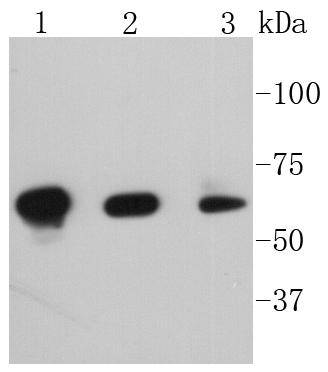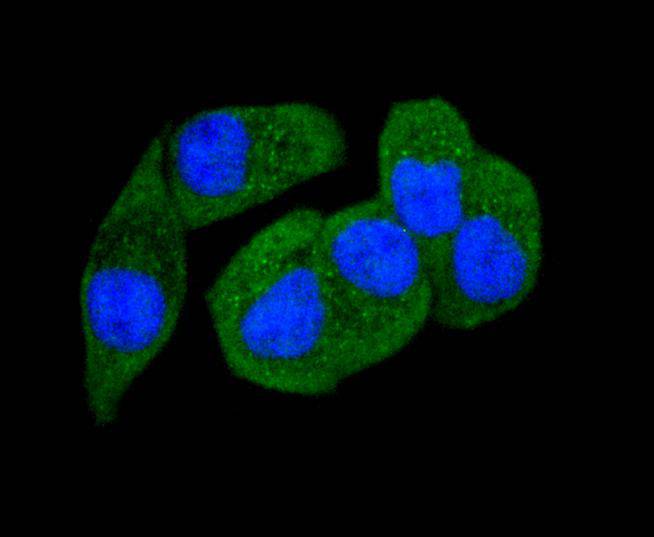Product Name :
PAK1/2/3 (Phospho-S144/S141/S139) polyclonal antibody Background :
Three isoforms of serine/threonine kinases, designated αPAK p68, βPAK p65 and γPAK p62, have been shown to exhibit a high degree of sequence homology with the S. cerevisiae kinase Ste 20, involved in pheromone signaling. The α, β and γPAK isoforms complex specifically with Rac1 and Cdc42 in their active GTP-bound state, inhibiting their intrinsic GTPase activity leading to their autophosphorylation. There are eight sites of autophosphorylation on γPAK, including Ser 19, Ser 141 and Thr 402, and phosphorylation of Ser 141 and Thr 402 is correlated with γPAK activation. Once phosphorylated and their affinity for Rac/Cdc42 reduced, the PAK isoforms disassociate from the complex to seek downstream substrates. Product :
Rabbit IgG, 1mg/ml in PBS with 0.02% sodium azide, 50% glycerol, pH7.2 Storage&Stability :
Store at +4°C after thawing. Aliquot store at -20°C or -80°C. Avoid repeated freeze / thaw cycles. Specificity :
PAK1/2/3 (Phospho-S144/S141/S139) polyclonal antibody detects endogenous levels of PAK1/2/3 protein only when phosphorylated at S144/S141/S139. Immunogen :
Synthetic phospho-peptide corresponding to residues surrounding Ser144 of human PAK1. Conjugate :
Unconjugated Modification :
Phosphorylation
PAK1/2/3 (Phospho-S144/S141/S139) polyclonal antibody Background :
Three isoforms of serine/threonine kinases, designated αPAK p68, βPAK p65 and γPAK p62, have been shown to exhibit a high degree of sequence homology with the S. cerevisiae kinase Ste 20, involved in pheromone signaling. The α, β and γPAK isoforms complex specifically with Rac1 and Cdc42 in their active GTP-bound state, inhibiting their intrinsic GTPase activity leading to their autophosphorylation. There are eight sites of autophosphorylation on γPAK, including Ser 19, Ser 141 and Thr 402, and phosphorylation of Ser 141 and Thr 402 is correlated with γPAK activation. Once phosphorylated and their affinity for Rac/Cdc42 reduced, the PAK isoforms disassociate from the complex to seek downstream substrates. Product :
Rabbit IgG, 1mg/ml in PBS with 0.02% sodium azide, 50% glycerol, pH7.2 Storage&Stability :
Store at +4°C after thawing. Aliquot store at -20°C or -80°C. Avoid repeated freeze / thaw cycles. Specificity :
PAK1/2/3 (Phospho-S144/S141/S139) polyclonal antibody detects endogenous levels of PAK1/2/3 protein only when phosphorylated at S144/S141/S139. Immunogen :
Synthetic phospho-peptide corresponding to residues surrounding Ser144 of human PAK1. Conjugate :
Unconjugated Modification :
Phosphorylation
-
 Western blot analysis of Phospho- PAK1(S144)+PAK2(S141)+PAK3(S139) on different lysates using anti-Phospho- PAK1(S144)+PAK2(S141)+PAK3(S139) antibody at 1/1,000 dilution. Positive control: Lane 1: Hela Lane 2: NIH/3T3 Lane 3: SH-SY-5Y
Western blot analysis of Phospho- PAK1(S144)+PAK2(S141)+PAK3(S139) on different lysates using anti-Phospho- PAK1(S144)+PAK2(S141)+PAK3(S139) antibody at 1/1,000 dilution. Positive control: Lane 1: Hela Lane 2: NIH/3T3 Lane 3: SH-SY-5Y -
 ICC staining Phospho- PAK1(S144)+PAK2(S141)+PAK3(S139) in Hela cells (green). The nuclear counter stain is DAPI (blue). Cells were fixed in paraformaldehyde, permeabilised with 0.25% Triton X100/PBS.
ICC staining Phospho- PAK1(S144)+PAK2(S141)+PAK3(S139) in Hela cells (green). The nuclear counter stain is DAPI (blue). Cells were fixed in paraformaldehyde, permeabilised with 0.25% Triton X100/PBS.
Bioworld Biotech only provide peptides for our antibodies and do not provide additional peptide customization services.
Price/Size :
USD 368/1mg/vial
Tips:
For phospho antibody, we provide phospho peptide(0.5mg) and non-phospho peptide(0.5mg).Describe :
Blocking peptides are peptides that bind specifically to the target antibody and block antibody binding. These peptide usually contains the epitope recognized by the antibody. Antibodies bound to the blocking peptide no longer bind to the epitope on the target protein. This mechanism is useful when non-specific binding is an issue, for example, in Western blotting (WB) and Immunohistochemistry (IHC). By comparing the staining from the blocked antibody versus the antibody alone, one can see which staining is specific; Specific binding will be absent from the western blot or IHC performed with the neutralized antibody.Formula:
Synthetic peptide was lyophilized with 100% acetonitrile and is supplied as a powder. Reconstitute with 0.1 ml DI water for a final concentration of 10 mg/ml.The purity is >90%,tested by HPLC and MS.
Storage:
The freeze-dried powder is more stable. For short time at 2-8°C. For long term storage store at -20°C.
Note :
This product is for research use only (RUO only). Not for use in diagnostic or therapeutic procedures.
 PAK1/2/3 (Phospho-S144/S141/S139) polyclonal antibody
PAK1/2/3 (Phospho-S144/S141/S139) polyclonal antibody  Datasheet
Datasheet COA
COA MSDS
MSDS SHIP
SHIP